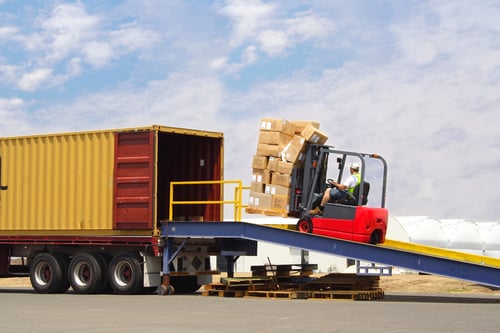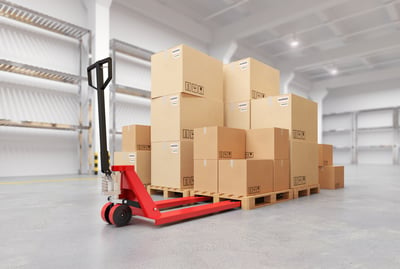Imagine that you need to ship an item with a carrier.
You run the math and estimate a shipping cost of $1000. A week later, the carrier comes back and bills you $3,500. You freak out a bit. Then you calm down. Then you ask why. The carrier reminds you of their penalty charges for over-length freight.
Six weeks later, you’re older and wiser. It wasn’t fun (it never is!) but you read all the carrier’s fine print. You carefully measure the weight and dimensions of your freight, and just to be sure, you go ahead and double check those details are 100 percent accurate on the bill of lading. The carrier charges you over double your expected outlay. After a nice, calming walk you go ahead and ask your carrier for an explanation. You discover your package was loaded onto the truck in a way that left tons of unusable space, which meant you had to pay through the nose.
If your company has encountered this kind of a situation, you’ve come head to head with one of the more complicated and opaque concepts embedded in supply chain management (and believe us, there are a lot of ‘em).
We’re talking about capacity, which as our extremely cool glossary will tell you, refers to “the amount of freight which can be carried in a truck or trailer, expressed in weight and measurement.”
In this blog post, we’ll take a quick look at why capacity in freight seems simple but really isn’t. Then we’ll show you how IL2000 manages capacity in a way that can save you a fortune in freight costs.
To get the explanatory ball rolling, picture a game of Tetris.
Welcome to entry-level 3D Tetris
You’re probably at least broadly familiar with the basic premise of this ’80s computer game classic. But if you’re not, here’s some footage of two champs battling it out in the 2018 Tetris World Championships. You get the idea. You have a big open space, regular and odd-shaped blocks drop down, and your job is to get them fitting together as efficiently as possible.
Throw in a third dimension, impose significant cash penalties when a player makes a mistake, and that — at the simplest possible level — is capacity in freight management.
 Welcome to the entry-level version of capacity management. No pressure.
Welcome to the entry-level version of capacity management. No pressure.
Oh, except that this is real life and a few interesting complications enter the mix.
You can’t control the shape…
In the beautifully abstract world of Tetris, you have precisely seven kinds of blocks to deal with. Of course, the physical shape of real freight is vastly more complicated with seemingly infinite permutations. But that’s just geometry. Understanding how capacity works in real life gets way murkier than that.
To begin with, the shape you think you’re dealing with may not be the shape your carrier sees. Let’s say you ship two pallets stacked on top of each other and shipped as one piece. Even if your carrier actually stacks them in this configuration, when they’re preparing your shipping bill they may split them up.
What your carrier sees (and of course charges you for) are two separate items of freight with a big chunk of unused space above them. And unless someone is paying very close attention, these adverse decisions just slip under your supply chain management radar.
… and actual blocks may vary
Then there’s the weight and density of your freight. While the designer of Tetris, Alexey Pajitnov, has never weighed in on this topic (pun intended), we can be reasonably confident that blue, green, and red blocks are all wrought from one functionally identical substance.
You probably noticed this already, but reality is made up of all kinds of stuff, from garbanzo beans to garden bricks. In the real-life version of the game, a carrier will ping you with hefty penalty charges if your freight item is large but light in weight. Why? Because otherwise, the space your low-density item occupies would impose a significant opportunity cost compared to shipping a similar-sized but heavier item.
Even at the beginner level, then, capacity management isn’t exactly a game a freight handling novice can expect to score well at.
Ready for pro-level?
 It’s tricky and time-intensive, but with enough experience under its belt, a company may still end up building a pretty good knowledge base of how to fine-tune freight capacity with one carrier.
It’s tricky and time-intensive, but with enough experience under its belt, a company may still end up building a pretty good knowledge base of how to fine-tune freight capacity with one carrier.
But an optimized supply chain rarely operates with just one carrier.
So imagine you’re playing this real-life equivalent of Tetris and the music ominously changes. Suddenly, three versions of the same game pop up on your screen, side by side — each demanding your attention, energy, and relentless concentration.
Congratulations! You just hit pro-level.
You’re dealing with different rules…
As a thin bead of sweat trickles down your brow and spectators gather around to witness your amazing block-wrangling prowess, you become aware of an extra vicious little complication.
The rules differ in each version you’re playing. The set of blocks in one game moves significantly faster than the others. You also notice that penalties work differently. If you leave a big chunk of vertical space in one game your points go down, but in another game, you’re penalized more when squares and rectangles are too close together.
Every carrier is different. Every carrier’s rules are different.
One carrier might bump you to a much higher rate if your shipment goes above a cubic footage threshold. Another might impose eye-watering additional costs if your shipment exceeds a given length. Yet another carrier will cost out your shipment as though it weren’t stackable — even if it is.
And all these rule variations won’t just impact your shipment costs by a few dollars here and there. The differences can be game-changing. You might pay a few hundred bucks to ship an item with carrier X, and end up paying thousands of dollars to ship exactly the same item with carrier Y — simply because every carrier calculates capacity differently.
… and shifting goals
Then there’s the other critical factor: you.
There’s no single perfect approach to optimizing your freight costs. Companies whose whole production line shuts down with a delayed delivery may have a zero-tolerance policy for shipment risk. Others with more forgiving timeframes will have more supply chain options. Companies that ship small and low-density products will make different freight handling decisions than a company shipping heavy or oversized products.
Or fragile products.
Or products that spoil.
In this complicated real-life game, there’s no cheat sheet that’ll work for everyone, because every company has different goals.
Here’s how IL2000 makes your life easier
Phew. Feeling stressed?
The bottom line is, capacity in freight management might seem like a simple concept. But it’s filled with complexity. There are so many ways your supply chain can be weighed down with unnecessary freight costs, simply because your product’s shape, your paperwork, or the carrier’s policy weren’t optimal.
So, how can IL2000 help you unlock new ways to play the game smarter?
1. Stronger representation
 Let’s say a carrier wants to impose a massive extra cost on a shipment. Your typical 3PL will look at the cost and compare it to the carrier’s policy. If it’s compliant on paper they’ll process payment. That isn’t how we roll. IL2000 pushes back. We scrutinize. We’ll investigate, find out what happened on the ground, and contest irregular charges. Having someone in your corner makes an enormous difference.
Let’s say a carrier wants to impose a massive extra cost on a shipment. Your typical 3PL will look at the cost and compare it to the carrier’s policy. If it’s compliant on paper they’ll process payment. That isn’t how we roll. IL2000 pushes back. We scrutinize. We’ll investigate, find out what happened on the ground, and contest irregular charges. Having someone in your corner makes an enormous difference.
In one recent case, we took photographs of how a shipment was loaded to prove the carrier was charging way above what they should. We saved our client thousands and positioned them for smoother shipments moving forward.
2. Deeper analysis
 If you’re managing your freight operation solo or even if you’re working with a conventional 3PL, the capacity game is strictly a move-by-move affair. A new block hits your radar and you or your third-party logistics provider scramble to find a way to deal with it as efficiently as possible.
If you’re managing your freight operation solo or even if you’re working with a conventional 3PL, the capacity game is strictly a move-by-move affair. A new block hits your radar and you or your third-party logistics provider scramble to find a way to deal with it as efficiently as possible.
What if you could see ten blocks ahead? IL2000’s audit team equips you with that advantage. As your shipping invoices make their way through our audit process, we scrutinize pricing trends. If we see an issue negatively impacting your supply chain bottom line, your account manager springs into action then and there, addressing it in real-time. We might recommend you package differently. We might see that shipment consolidation will improve your bottom line. Or perhaps sidestepping from LTL to TL can deliver big gains in cost-efficiency.
Decades of experience with freight handling has leveled up our team’s supply chain insight so that we no longer see freight challenges as a block-by-block challenge. We take a higher-level perspective to make your unique game of capacity progressively easier over time. IL2000 shifts your game from reactive to proactive.
3. More options
 Greater supply chain expertise equates to more options. The combination of our proprietary transportation management system, enhanced BI, and end-to-end supply chain expertise sets you up to consistently make smarter decisions with less effort.
Greater supply chain expertise equates to more options. The combination of our proprietary transportation management system, enhanced BI, and end-to-end supply chain expertise sets you up to consistently make smarter decisions with less effort.
Let’s say something unexpected happens and you get the worst possible “block” at the worst possible time. With an entire team of professionals helping you manage your freight operation, you gain the benefit of multiple solutions. We help you tackle your next move from all angles. Maybe we utilize a different carrier for a certain kind of shipment. Perhaps we work with your carrier to change how it’s loaded. Or we’ll leverage spot quotes to balance cost against delivery time.
A non-specialist 3PL sees your options in two dimensions, locking you into a narrow repertoire of moves. Our team can work a wide range of supply chain solutions, giving your freight operation greater agility and enhanced cost-efficiency. More brains. More options.
Are capacity issues complicating your supply chain? Unlock cheat mode
 The notion of capacity seems so simple. Blocks of freight arrive, blocks of freight are neatly stashed on transport for smooth and predictable results. Then hit restart and play it over. The reality is far more complicated. Capacity is a fast-moving game of 3D Tetris with elastic rules, shifting goalposts, and carriers calling the shots. Oh, and very real cash is at stake.
The notion of capacity seems so simple. Blocks of freight arrive, blocks of freight are neatly stashed on transport for smooth and predictable results. Then hit restart and play it over. The reality is far more complicated. Capacity is a fast-moving game of 3D Tetris with elastic rules, shifting goalposts, and carriers calling the shots. Oh, and very real cash is at stake.
Unlock cheat mode with IL2000.
Our people have been playing this game for decades. We’ll level up your freight operations with more ways to keep your supply chain lean, fast and cost-effective.
It’s your move! Start now with a no obligation supply chain analysis.

